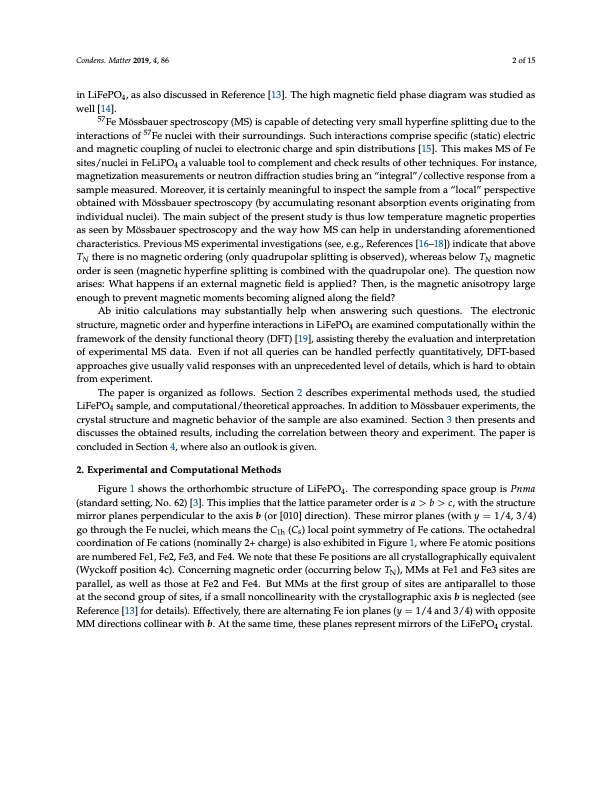
PDF Publication Title:
Text from PDF Page: 002
Condens. Matter 2019, 4, 86 2 of 15 in LiFePO4, as also discussed in Reference [13]. The high magnetic field phase diagram was studied as well [14]. 57Fe Mössbauer spectroscopy (MS) is capable of detecting very small hyperfine splitting due to the interactions of 57Fe nuclei with their surroundings. Such interactions comprise specific (static) electric and magnetic coupling of nuclei to electronic charge and spin distributions [15]. This makes MS of Fe sites/nuclei in FeLiPO4 a valuable tool to complement and check results of other techniques. For instance, magnetization measurements or neutron diffraction studies bring an “integral”/collective response from a sample measured. Moreover, it is certainly meaningful to inspect the sample from a “local” perspective obtained with Mössbauer spectroscopy (by accumulating resonant absorption events originating from individual nuclei). The main subject of the present study is thus low temperature magnetic properties as seen by Mössbauer spectroscopy and the way how MS can help in understanding aforementioned characteristics. Previous MS experimental investigations (see, e.g., References [16–18]) indicate that above TN there is no magnetic ordering (only quadrupolar splitting is observed), whereas below TN magnetic order is seen (magnetic hyperfine splitting is combined with the quadrupolar one). The question now arises: What happens if an external magnetic field is applied? Then, is the magnetic anisotropy large enough to prevent magnetic moments becoming aligned along the field? Ab initio calculations may substantially help when answering such questions. The electronic structure, magnetic order and hyperfine interactions in LiFePO4 are examined computationally within the framework of the density functional theory (DFT) [19], assisting thereby the evaluation and interpretation of experimental MS data. Even if not all queries can be handled perfectly quantitatively, DFT-based approaches give usually valid responses with an unprecedented level of details, which is hard to obtain from experiment. The paper is organized as follows. Section 2 describes experimental methods used, the studied LiFePO4 sample, and computational/theoretical approaches. In addition to Mössbauer experiments, the crystal structure and magnetic behavior of the sample are also examined. Section 3 then presents and discusses the obtained results, including the correlation between theory and experiment. The paper is concluded in Section 4, where also an outlook is given. 2. Experimental and Computational Methods Figure 1 shows the orthorhombic structure of LiFePO4. The corresponding space group is Pnma (standard setting, No. 62) [3]. This implies that the lattice parameter order is a > b > c, with the structure mirror planes perpendicular to the axis b (or [010] direction). These mirror planes (with y = 1/4, 3/4) go through the Fe nuclei, which means the C1h (Cs) local point symmetry of Fe cations. The octahedral coordination of Fe cations (nominally 2+ charge) is also exhibited in Figure 1, where Fe atomic positions are numbered Fe1, Fe2, Fe3, and Fe4. We note that these Fe positions are all crystallographically equivalent (Wyckoff position 4c). Concerning magnetic order (occurring below TN), MMs at Fe1 and Fe3 sites are parallel, as well as those at Fe2 and Fe4. But MMs at the first group of sites are antiparallel to those at the second group of sites, if a small noncollinearity with the crystallographic axis b is neglected (see Reference [13] for details). Effectively, there are alternating Fe ion planes (y = 1/4 and 3/4) with opposite MM directions collinear with b. At the same time, these planes represent mirrors of the LiFePO4 crystal.PDF Image | Mossbauer Spectroscopy of Triphylite (LiFePO4) at Low Temperatures

PDF Search Title:
Mossbauer Spectroscopy of Triphylite (LiFePO4) at Low TemperaturesOriginal File Name Searched:
condensedmatter-04-00086.pdfDIY PDF Search: Google It | Yahoo | Bing
Sulfur Deposition on Carbon Nanofibers using Supercritical CO2 Sulfur Deposition on Carbon Nanofibers using Supercritical CO2. Gamma sulfur also known as mother of pearl sulfur and nacreous sulfur... More Info
CO2 Organic Rankine Cycle Experimenter Platform The supercritical CO2 phase change system is both a heat pump and organic rankine cycle which can be used for those purposes and as a supercritical extractor for advanced subcritical and supercritical extraction technology. Uses include producing nanoparticles, precious metal CO2 extraction, lithium battery recycling, and other applications... More Info
| CONTACT TEL: 608-238-6001 Email: greg@infinityturbine.com | RSS | AMP |